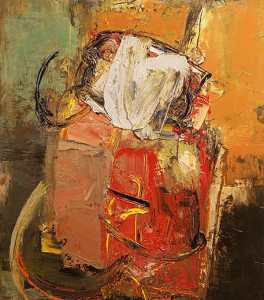“BLACK DOG” Solo Exhibition – Rebecca Gallery, Toronto
Gary Michael Dault – Toronto, September 12, 2006

Ina Puchala and I share this: we are both clearly and probably hopelessly in thrall to the wonders of paint, to the chemistry (and the alchemistry) of it, to its strange, messy palpability, its recalcitrant thereness. And to its mysterious ability to be expressive, eloquent, its ability to utter.
What is it that is so moving about oil paint? Its ground colour in suspension? Its molecules, its corpuscles of hue kept aloft and alive in a silky medium, so buoyant they dance and scintillate long after they have dried hard as stone? The fierce docility of the stuff that allows you to have your way with it—until you’re attention flags, and it turns on you and pretends, like an exhausted child, to be dull and lumpen?
What I like about Ina Puchala’s oil paintings is the way they so accurately and minutely betray her skirmishes and collaborations with the pigment, her little bounded agons (none of the paintings is bigger than 21” X 18”), within which she and the pigment either cooperate or contend—or, most excitingly, do both. Every smear, sweep, swirl, pool, puddle, coagulation, hook or eye of it, every impress of one hue upon another, every juxtaposition of one hue to the next hue, speaks to the whole work, and, ultimately, to the viewer. A painting is a directed cacophony, a message in a bottle, a cry from the heart, tracks in the snow, footprints on the sand, the utterances of cloud, leaf, air and earth, a record of the body’s breathing and of its improbable endurance, its ductility and tenacity.
For paint is alive, and so is the painter, and there is a fragrant, flowery war between them until, all passion spent, the peace of reconciliation between master and medium falls over the field of battle—the canvas or paper or, in Puchala’s case, the mylar to which the pigment is consigned.
Colour is inexplicable. Puchala’s hot golds and creamy flesh-tones, her wicked shots of sea-blue, her quick, vegetative emerald greens and heated mineralized reds—almost, one imagines, as warm to the touch as bricks in the sun—constitute a language. Paint speaks as clearly and as eloquently (and inchoately) as music does. Painting is optical music.
To anyone who might feel impelled to ask Puchala what her paintings are actually about, I commend to him, to her, an indispensable book by art historian James Elkins called What Painting Is (Routledge, 2000). In it, Elkins talks confidently about “the kinds of thought that are taken to be embedded in paint itself”. Paint, writes Elkins, “is a cast made of the painter’s movements, a portrait of the painter’s body and thoughts. The muddy moods of oil paints are the painter’s muddy humours, and its brilliant transformations are the painter’s unexpected discoveries. Painting is an unspoken and largely unrecognized dialogue, where paint speaks silently in masses and colours and the artist responds in moods…Paint is water and stone, and it is also liquid thought” (p.5)
Ina, Both of these reviews are so beautifully written and so absolutely describe your sensuous paintings in a way that gets down to your brain waves. Your work is remarkable and theses reviews just define who you are and with what passion and committment is invested in your work. It reflects the intensity, experience and artistry of a mature artist. I look forward to seeing your work in the Out of Bounds exhibition. I wish that I could say that I have reached the same level of developement and oneness with my work that you have. Well, always something to challenge and entice us to keep going. Susan